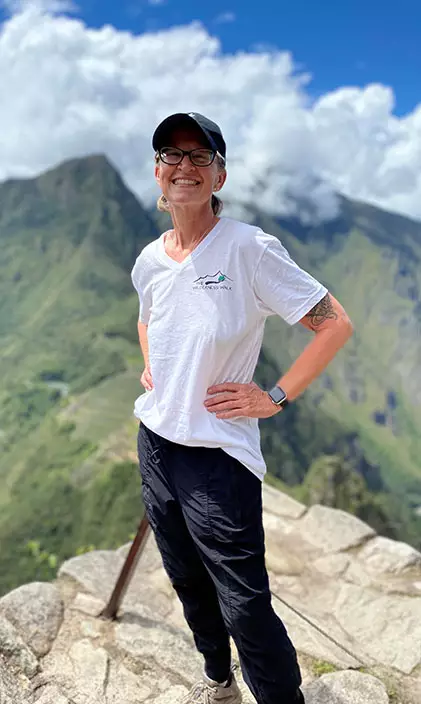How to work from anywhere

Written by Robert Strohmeyer

Working on the road
During the COVID-19 pandemic, Sol Rapson, a sales development representative for a technology company, found himself in a predicament similar to that of many people at the time: isolated at home and feeling restless. Unlike many people, however, Rapson acted on his desire to escape. He loaded up a used minivan equipped with a fold-down bed and headed out on the highways of America. Working a solid Monday through Friday from coffee shops, parks and sometimes the back of the van, he not only broke free from the confines of lockdown but also consistently delivered top-performing numbers for his boss.
Emboldened by his ability to balance high job performance with a growing love for travel, Rapson continued what he started. Since 2020, he’s made extended trips to Portugal, Spain and France; he spent three months in Mexico; and he’s visited all but about five U.S. states.
“Hitting my numbers gave me a lot of flexibility,” says Rapson, referring to his performance targets at work. “My manager was happy, and she knew traveling was making me happy, so she was totally supportive. I think she knew being happy doing something I loved only made me better at my work.”

Christine Hunter embraces being a digital nomad.
About the same time, Christine Hunter also felt the open road calling. As a certified grief coach based in the Bay Area, Hunter was self-employed and had already been meeting clients via Zoom for some time. An empty nester with newfound freedom, she rekindled a dream she’d had since her 20s: She applied some proceeds from the sale of her house toward a souped-up Dodge Ram ProMaster van (equipped with a two-burner stove, refrigerator and tiny bathroom), and took her life and work on the road. In just the past year, Hunter has traveled through 33 states, staying overnight in 135 locations, including 22 national parks and a stint near Machu Picchu in Peru.
What do Rapson’s and Hunter’s stories have in common? Both demonstrate that, thanks to technology and a changing workplace culture, mobile work is possible for many people. For those who work at companies that support remote travel (and not all do — check with your HR department), or for those who work for themselves, here are some steps to keep in mind.
Stay connected
Being productive and successful at work can require some special arrangements on the road. The biggest requirement for any digital nomad is internet connectivity. Hunter’s solution involved three modes of connection: an AT&T iPhone and Verizon-enabled iPad, both of which can serve as Wi-Fi hotspots, plus a Starlink satellite dish.
Rapson likewise carried two different Wi-Fi hotspots in addition to his cellphone and typically sought out coffee shops with good wireless access as his go-to internet source.
“My only real problems with connectivity were in Mexico City, where I sometimes had trouble finding good Wi-Fi,” he says.
Having a good international roaming plan on his mobile phone helped ensure he had a fallback plan to get connected. He recommends that anyone planning to work while traveling put effort into scouting locations well ahead of important calls in order to find the best Wi-Fi spots or locations with strong mobile data service.
Rapson frequently visited newfound cafes on weekends to test their Wi-Fi, so he’d be ready to head for the best one Monday morning.
“There’s basically no cell service inside national parks,” cautions Hunter, “and Starlink doesn’t work under tree canopy of a forest.”
However, near the visitor centers of any park, Hunter has typically found good cellular signals and open skies for satellite connections. So, on days with client calls, she generally heads for the visitor center parking lot. While she found cellular service in Peru lacking, she did her research in advance and chose hotels reputed to have reliable Wi-Fi connections, so she had no client-call disruptions.
Balance work and travel
Both Rapson and Hunter stress the primacy of reliability and availability while traveling, and both have gone out of their way to ensure they never miss a call due to travel.
For Rapson, a certain amount of his workload is asynchronous, like emailing prospects and colleagues or reaching out via social media channels to schedule sales calls. When possible, he schedules live calls on one of a few days each week, dedicating other days to the asynchronous tasks.
Likewise, Hunter tries to schedule client calls for only a few days per week. This arrangement frees her up to travel more and spend less time in one single place.
“People are very understanding when you’re up front about your location,” says Hunter, emphasizing the importance of transparency. “My clients all know when I’m dialed in from the van, and usually their response is that they wish they could do something like that themselves. It’s never been a problem, because I’ve always been available, and I’ve only had about five actual connection problems that disrupted a client call in the past year. That can happen even when you’re working from home. It helps that I’ve never had any single client experience an issue more than once.”
Aside from connectivity, Rapson also points out the importance of knowing and accommodating time-zone differences on international journeys. Lining up business calls in California from Portugal and Spain required him to adjust his sleep and travel schedule to ensure he’d be fresh-faced in front of colleagues and customers even though it was past midnight in Lisbon or Barcelona.
Test the waters first
While Rapson and Hunter now travel extensively without disruption to their work, they both recommend that anyone following in their nomadic footsteps first test things out with a trial trip or two.
By going on a road trip with a friend before deciding to take the plunge into a solo cross-country trip, Rapson developed the confidence and experience necessary to work from the road.
Hunter also took a short trip once she got her van equipped for travel. That kind of shakedown trip is important for helping you acclimate without risking serious disruption to your work.
While working as a digital nomad isn’t for everyone, it can be possible for those with the right employer and mindset. Just keep this last piece of advice from Hunter in mind: Don’t wait too long to try.
Read more articles like this:

ABOUT THE AUTHOR
Robert Strohmeyer is a serial entrepreneur and executive with more than 30 years of experience starting and running companies. He has served in leadership roles at three successful software startups over the past decade, and his writing on business and technology has appeared in such publications as Wired, PCWorld, Forbes, Executive Travel, Smart Business, Businessweek and many others. He lives in the San Francisco Bay Area.
This article has been vetted by University of Phoenix's editorial advisory committee.
Read more about our editorial process.


